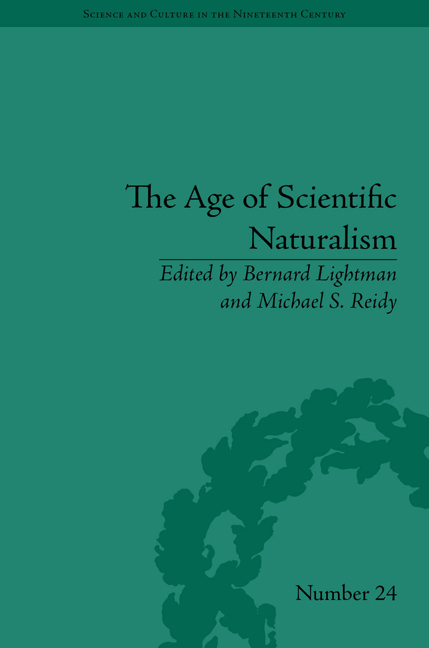Book contents
- Frontmatter
- CONTENTS
- Dedication
- Acknowledgements
- List of Contributors
- List of Figures
- Introduction: John Tyndall, Scientific Naturalism and Modes of Communication
- Part I John Tyndall
- Part II Scientific Naturalism
- 4 Herbert Spencer and the Metaphysical Roots of Evolutionary Naturalism
- 5 Evolutionary Mathematics: William Kingdon Clifford's Use of Spencerian Evolutionism
- 6 The ‘Great Plan of the Visible Universe’: William Huggins, Evolutionary Naturalism and the Nature of the Nebulae
- 7 Alfred Newton: The Scientific Naturalist Who Wasn't
- Part III Communicating Science
- Notes
- Index
6 - The ‘Great Plan of the Visible Universe’: William Huggins, Evolutionary Naturalism and the Nature of the Nebulae
from Part II - Scientific Naturalism
- Frontmatter
- CONTENTS
- Dedication
- Acknowledgements
- List of Contributors
- List of Figures
- Introduction: John Tyndall, Scientific Naturalism and Modes of Communication
- Part I John Tyndall
- Part II Scientific Naturalism
- 4 Herbert Spencer and the Metaphysical Roots of Evolutionary Naturalism
- 5 Evolutionary Mathematics: William Kingdon Clifford's Use of Spencerian Evolutionism
- 6 The ‘Great Plan of the Visible Universe’: William Huggins, Evolutionary Naturalism and the Nature of the Nebulae
- 7 Alfred Newton: The Scientific Naturalist Who Wasn't
- Part III Communicating Science
- Notes
- Index
Summary
Introduction
The nature of the nebulae was one of the most pressing questions for astronomers throughout the nineteenth century. It was also a central concern for others, including many popularizers of science, one of whom was the anonymous author of the Vestiges of the Natural History of Creation (1844). By 1864, matters had reached such a pass that Edward Sabine, the President of the Royal Society, reckoned that nebular astronomy had reached a ‘crisis’. The resolution of this crisis was widely seen as a great, if not the greatest, achievement of William Huggins.
Writing for the Nineteenth Century in 1897, Huggins revisited his original observations of nebulae three decades earlier. Huggins invited readers to join him in his observatory at Tulse Hill near London on 29 August 1864 (see Figure 6.1 for a depiction of Huggins in his observatory).
On that night, Huggins recalled, he had turned his telescope and attached spectroscope to the heavens to investigate the light of a nebula, the first time he had done so:
Was I not about to look into a secret place of creation? I looked into the spectroscope. No spectrum such as I expected! A single bright line only! At first, I suspected some displacement of the [spectroscope's] prism, and that I was looking at a reflection of the illuminated slit from one of its faces. This thought was scarcely more than momentary; then the true interpretation flashed upon me.
[…]
- Type
- Chapter
- Information
- The Age of Scientific NaturalismTyndall and his Contemporaries, pp. 113 - 136Publisher: Pickering & ChattoFirst published in: 2014



